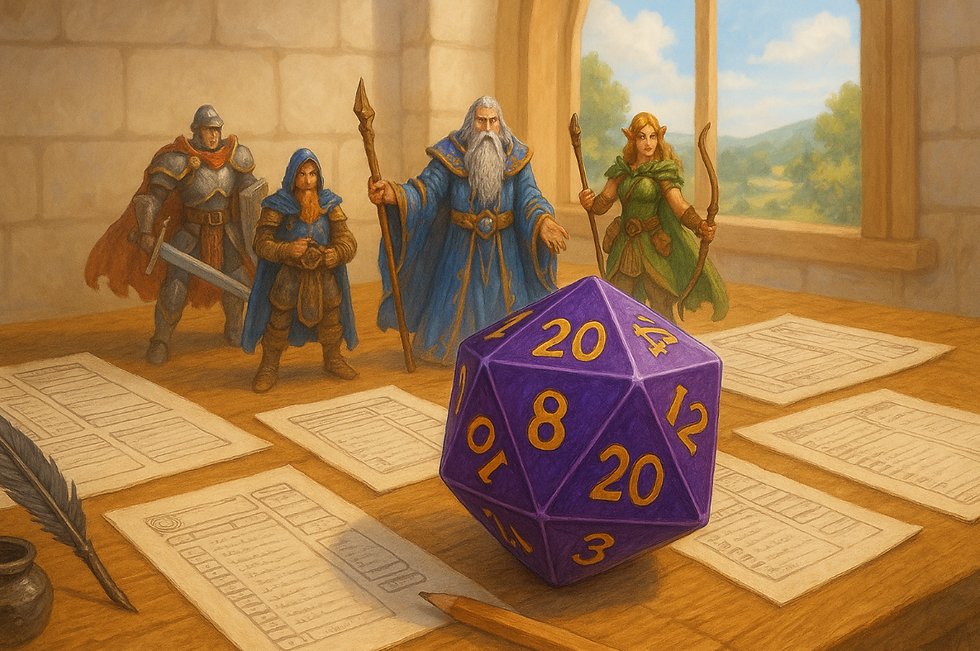Understanding the Five Archetypes of D&D Players: A Guide for DMs
- Danny McKeever
- Mar 22, 2023
- 3 min read

There have been several different categorization systems for D&D players developed over the years. Here are some of the most well-known ones:
Gamemastering (1981) by Brian Jamison: Jamison identified three broad categories of player styles - Actor, Explorer, and Solver.
Dungeons & Dragons Player Types (1988) by Richard Bartle: Bartle's categorization system identified four types of players - Achievers, Explorers, Socializers, and Killers.
Player Types in Role-Playing Games (1999) by Nicholas Yee: Yee's study of MMORPGs identified three primary player motivations - Achievement, Socialization, and Immersion.
GNS Theory (2004) by Ron Edwards: Edwards' theory categorizes play styles into three categories - Gamism, Narrativism, and Simulationism.
D&D Player Archetypes (2010) by Ashley Warren: Warren identified five archetypes of D&D players - Storytellers, Power Gamers, Casual Players, Completionists, and Specializers.
Each of these categorization systems offers a different way of looking at player motivations and styles, and can be useful for DMs and players alike in understanding and catering to the preferences of different players.
The one that I am most interested in is the D&D Player Archtypes by Ashley Warren. In these blogs I will explore the different archetypes, how to craft your campaign to these archetypes, helping characters build PC’s that align to their archetypes, how different archetypes perform in battle and lastly how a DM can ensure he is hitting the mark for his PC’s.
Archetypes:
This is the player's preferred style of gameplay. It includes, Storytellers, Power Gamers, Casual Players, Completionists, and Specializers.
To engage Storyteller players, DMs can provide detailed and richly imagined game worlds, complete with interesting NPCs and intricate plotlines.
To engage Power Gamers, DMs can offer challenging combat encounters and provide opportunities for character optimization and customization.
To engage Casual Players, DMs can provide a welcoming and inclusive environment that emphasizes the social aspect of the game.
To engage Completionists players, DMs can provide a rich and expansive game world with plenty of side quests and hidden treasures to discover.
To engage Specializer players, DMs can provide opportunities for character specialization and skill development.
There is so much content on this subject that I have broken this topic into 4 different blogs.
In this blog, we explore the five archetypes of D&D players and offer tips on how to engage and cater to each type of player. From Storytellers to Completionists, each archetype has its own unique motivations and play styles. As a DM, it's important to understand these different archetypes and tailor your game accordingly to provide the best experience for your players.
Character creation is an essential aspect of the Dungeons & Dragons experience, and it sets the stage for your unique adventures in the game world. As a player, you must consider your preferred archetype when developing your character to ensure a fulfilling and enjoyable gaming experience.
In this blog, we will explore the different archetypes and discuss how to create a character that aligns with your playstyle, while taking into consideration the various classes and their potential synergies or clashes with each archetype.
A character's backstory is the foundation upon which their motivations, goals, and personality are built, making it a crucial element of any Dungeons & Dragons campaign. Tailoring your character's backstory to your preferred archetype can enhance your immersion in the game world and provide a more satisfying gaming experience. In this blog, we'll explore how to create compelling backstories for each archetype and provide three examples for each to inspire your creativity.
Combat is a crucial part of the D&D experience, and each archetype approaches combat differently. In this blog, we provide tips for mastering combat that caters to each archetype, whether you're a player or a DM.
Catering to each player archetype is key to creating a successful D&D campaign. By creating a flexible game world, varying the gameplay, using personalized content, and incorporating player feedback, DMs can create a game experience that engages and satisfies each archetype. Remember, having some content for each archetype in each game session is crucial to keeping everyone engaged and invested in the game.




Comments